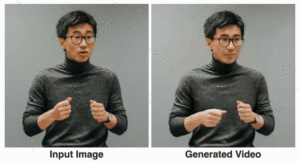Google’s VLOGGER AI: Crafting Avatars or Unleashing Deepfakes?


The ability to generate lifelike moving images through artificial intelligence has reached astonishing levels. From Open AI’s Sora, offering breathtaking imaginary fly-throughs, to Google’s latest innovation, VLOGGER, the question arises: what should we do with this technology?
Google’s VLOGGER AI model has taken a significant leap forward by producing high-resolution video avatars from just a single photograph. Developed by Google scholar Enrick Corona and his team, this technology brings to life realistic-looking synthetic humans, complete with accurate facial expressions and body movements.
This breakthrough has the potential to revolutionize various sectors. On one hand, it could enhance helpdesk interactions by providing more relatable avatars, fostering empathy in online communication. On the other hand, there’s a looming concern about the misuse of this technology, potentially leading to a new wave of convincing deepfakes.

The capabilities of VLOGGER AI; Source: Tom’s Guide
Extreme Avatar-ing…
The implications of VLOGGER are profound. While it promises to empower online communication, education, and virtual assistance, it also raises serious ethical questions. Corona’s team acknowledges the need for careful consideration of the societal impact of this technology, yet supplementary materials addressing this concern are currently unavailable.
In their paper, “VLOGGER: Multimodal Diffusion for Embodied Avatar Synthesis,” Corona’s team aims to surpass the limitations of existing avatar technologies. Unlike previous tools that often produce incomplete representations, the model generates high-resolution videos with diverse facial expressions, gestures, and full-body movements. This is a big step towards creating more authentic and engaging human-like avatars.
Behind the scenes, the software utilizes recent advancements in deep learning, including multi-modality, large language models, and diffusion. By training neural networks to associate audio with video frames, this technology achieves remarkable synchronization between speech and motion. This intricate process involves predicting actions frame by frame, resulting in seamless animation.
Multi-modality, the convergence of various data types such as text, audio, images, and video, allows this software to synthesize comprehensive representations of human expression and behavior. Furthermore, the use of large language models, like Open AI’s GPT-4, enables VLOGGER to interpret natural language inputs and translate them into meaningful actions. This capability enhances the versatility and usability of the software across different applications.
Another key aspect of this technology is diffusion, a method borrowed from molecular physics, which involves introducing noise into an image and reconstructing it to train neural networks. This process, coupled with the attention mechanism of Transformers, enables VLOGGER to predict and generate high-resolution video frames accurately.
Moreover, VLOGGER’s training dataset, MENTOR, comprising 800,000 identities and 2,200 hours of video, represents a significant milestone in data collection for avatar synthesis. This extensive dataset allows VLOGGER to capture a wide range of human expressions and movements with unprecedented fidelity.
…But Tread with Caution
But with great power comes great responsibility. As VLOGGER opens new frontiers in avatar synthesis, it also raises concerns about potential misuse. The ability to manipulate high-resolution videos in real-time could be exploited to create convincing deepfakes, posing risks to privacy, security, and trust.
As VLOGGER continues to push the boundaries of AI-driven avatar synthesis, it will continue to raise important questions about accountability and oversight. While the technology holds immense promise for applications such as virtual assistance and online communication, its potential for misuse underscores the unequivocal need for ethical guidelines and regulatory frameworks.
Looking ahead, society must grapple with the ethical challenges posed by AI-driven avatar technologies like VLOGGER. While they offer tremendous potential for innovation, they also demand robust safeguards to prevent misuse and abuse. Its development also highlights the importance of responsible AI governance to ensure that it is used ethically and responsibly. As we embark on this new frontier of AI-driven avatar synthesis, it’s essential to priorities transparency, accountability, and ethical considerations to maximize the benefits of this groundbreaking technology.
[To be continue]
